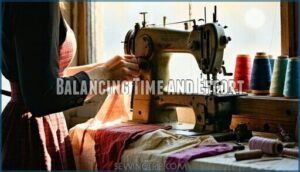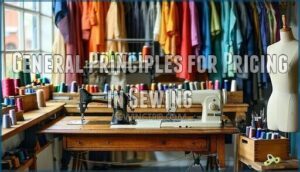This site is supported by our readers. We may earn a commission, at no cost to you, if you purchase through links.
 Figuring out how much to charge for sewing doesn’t have to feel like threading a needle in the dark. You’ll want to calculate your hourly rate (typically $15-50) plus materials, then factor in your skill level and local market rates.
Figuring out how much to charge for sewing doesn’t have to feel like threading a needle in the dark. You’ll want to calculate your hourly rate (typically $15-50) plus materials, then factor in your skill level and local market rates.
Simple alterations might run $10-25, while custom garments can fetch $50-300 depending on complexity. Don’t sell yourself short like a clearance rack find – your time and expertise matter.
Consider multiplying fabric costs by 2-3 for basic projects, or use an hourly rate plus materials for complex work. The secret sauce lies in understanding which pricing method works best for different project types, and using your skill level to inform your decisions.
Table Of Contents
- Key Takeaways
- Factors to Consider When Pricing Sewing Projects
- Different Pricing Formulas for Sewing Projects
- Insights From Experienced Sellers on Pricing
- Determining Hourly Rate for Sewing Projects
- Pricing Strategies for Sewing Businesses
- Challenges and Benefits of Pricing in The Sewing Business
- Increasing Revenue in The Sewing Business
- Personal Experiences With Pricing in Sewing
- General Principles for Pricing in Sewing
- Frequently Asked Questions (FAQs)
- Conclusion
Key Takeaways
- Calculate your true hourly rate based on skill level – You’ll want to charge $15-25 for basic alterations if you’re starting out, but don’t hesitate to command $40-100 per hour for complex custom work as your expertise grows.
- Factor in all costs, not just materials – You’re missing money if you only count fabric costs; include thread, notions, machine wear, electricity, and administrative time, like client communication and project photography.
- Use proven pricing formulas for consistency – You can multiply material costs by 2-5x, depending on complexity, or combine your hourly rate plus materials plus a reasonable profit margin to ensure you’re covering all expenses.
- Value your expertise and don’t undersell yourself – You’re providing professional craftsmanship that deserves fair compensation; research local competitors, but don’t automatically match the lowest prices, since quality work commands premium rates.
Factors to Consider When Pricing Sewing Projects
When you’re setting prices for your sewing projects, you need to take into account several key factors that directly impact your profitability.
Your pricing should reflect the time you spend, the materials you use, your skill level, and what the market will support.
Time and Labor Intensity
Every stitch tells a story of time invested.
Break down each task when pricing sewing projects—pattern cutting, pinning, and detailed work all count toward your sewing labor costs.
Track actual project duration versus estimates.
Sewing complexity directly impacts your sewing rate per hour.
Advanced skill level commands higher pricing.
Don’t undervalue sewing time; your sewing expertise deserves fair compensation that reflects true labor costs, considering the true labor costs.
Materials and Supplies
After calculating your time investment, you’ll need to account for every material that goes into your project.
Fabric sourcing represents your biggest expense, but don’t overlook the smaller costs that add up quickly.
Thread quality matters – cheap thread breaks easily and costs you time.
Notion costs include zippers, buttons, interfacing, and elastic that can easily reach $10-20 per project.
A key element is understanding sewing notions pricing for budgeting.
Equipment depreciation is real and should be considered when calculating costs.
Your sewing machine, cutting mats, and tools wear down with each use.
Factor these hidden costs into your sewing pricing guide calculations to ensure accuracy.
Smart sewers track bulk discounts from suppliers and pass savings to clients when possible.
A reliable sewing cost calculator should include fabric, notions, thread, and equipment wear when pricing sewing projects accurately.
Skill and Expertise
Your skill level directly impacts your sewing rates.
Experience matters when setting prices—beginners shouldn’t match expert pricing.
Training investment in specialized techniques like couture or leather work justifies higher rates.
Niche specialization commands premium pricing.
Start at $10-15 hourly for basic alterations, then increase as expertise grows.
Expertise justification comes through consistent quality and advanced sewing skills that clients can’t find elsewhere.
Market Demand and Competition
Understanding your local competition and online marketplaces helps you set competitive pricing that reflects true market value.
Research pricing trends across platforms like Etsy, Facebook Marketplace, and local tailoring shops to gauge customer willingness to pay. Don’t undersell yourself just to beat competitors.
The market is seeing growth, driven by fashion apparel demand and DIY culture.
Consider these market factors when setting your sewing prices:
- Niche demand – Specialty items command premium rates
- Geographic location – Urban areas typically support higher pricing
- Seasonal fluctuations – Wedding season increases dress alteration demand
- Customer demographics – Target audience affects price sensitivity
- Service uniqueness – Custom work justifies higher rates than basic alterations
Different Pricing Formulas for Sewing Projects
You need reliable formulas to calculate fair prices for your sewing projects, whether you’re making simple alterations or complex custom garments.
These three proven pricing methods help you determine accurate costs while ensuring you earn what your time and skills are worth.
Multiples of Material Cost
Smart sewing pricing strategy starts with understanding markup percentages for your projects.
Standard fabric tiers determine your baseline, while complexity scaling adjusts rates upward for intricate designs.
Setting sewing prices using material multipliers creates consistent custom sewing rates across all projects.
For complex projects, consider how the project design impacts costs.
| Project Type | Markup Multiplier |
|---|---|
| Basic alterations | 2x-2.5x material cost |
| Standard garments | 3x-3.5x material cost |
| Complex designs | 4x-5x material cost |
| Couture pieces | 6x-8x material cost |
Your minimum markup should cover notions multiplier plus overhead expenses for sustainable sewing cost calculation.
Material Cost + Hourly Rate
This approach combines fabric pricing and notion costs with your sewing rate per hour for transparent pricing.
Start by calculating all material expenses, then multiply your hours by your hourly rate.
Add these together for your base price, then include a reasonable profit margin.
This sewing cost calculation method guarantees you’re compensated fairly while maintaining competitive pricing in the market.
Market Comparison
Market research reveals competitor pricing patterns that shape your sewing business prices.
Study local sewing service rates and average sewing prices to establish baseline expectations.
Geographic influence affects regional market trends substantially, and premium justification comes through service differentiation like superior craftsmanship or faster turnaround times.
Position your sewing rate per hour competitively while highlighting unique value propositions that distinguish your services from standard offerings.
Insights From Experienced Sellers on Pricing
You’ll learn more from real sellers who’ve figured out pricing through trial and error than any formula can teach you.
These experienced sewers share their practical methods for balancing material costs, hourly rates, and hidden expenses to build profitable businesses, using trial and error to figure out their pricing strategies.
Material Cost Vs Hourly Rate
Experienced sewers split on whether fabric pricing or hourly rate should drive your sewing project cost. While material cost seems straightforward, savvy seamstresses know labor value matters more.
Your rate justification should reflect your expertise, not just notions costs.
Consider these factors when setting sewing service rates:
- Expert tailoring and finishing techniques
- Project complexity and pattern difficulty
- Amount of detailed handwork required
Incorporating Fees and Expenses
Beyond material costs and hourly rates, you’ll face hidden costs that eat into profits.
Equipment depreciation, consumable pricing for threads and needles, and material markups add up quickly.
Factor in platform fees, shipping supplies, and photography expenses when pricing handmade items.
Smart bulk discounts can offset some expenses, but don’t let sewing commission rates suffer from overlooking these essential business costs, including material markups.
Considering Personal Value
Setting your sewing worth isn’t just math—it’s about recognizing your expertise and avoiding underselling dangers.
Your sewing skill deserves fair compensation that reflects years of practice and creative problem-solving abilities.
5 Ways to Value Your Sewing Experience:
- Apply the "confidence tax" – charge 20% more than you think you’re worth
- Calculate expertise justification – add $5-10/hour for specialized techniques you’ve mastered
- Balance passion vs. profit – loving sewing doesn’t mean working for peanuts
- Research competitor pricing – verify your rates match your skill level
- Practice self-worth pricing – value your time like any professional service provider would
Determining Hourly Rate for Sewing Projects
Your hourly rate forms the foundation of profitable sewing work, but calculating it requires more than just considering your sewing time.
You’ll need to account for all project tasks, from pattern cutting to finishing touches, while comparing your rates to industry standards that range from $10-15 for beginners to $50+ for specialized work, including considering your sewing time.
Accounting for All Tasks
You’re missing half your work when you only count sewing time.
Task breakdown reveals the hidden overheads: photography, listing products, customer communication, and packaging.
Smart project management tracks every minute spent on invoicing strategies and workflow optimization.
Most sewers undercharge because they ignore administrative tasks that easily double your actual time investment.
Many sewers research the sewing hourly rate to better understand pricing.
The importance of considering all aspects of a project, including admin work, cannot be overstated.
| Task Category | Time Investment | Pricing Impact |
|---|---|---|
| Actual Sewing | 60% of project | Base hourly rate |
| Admin Work | 25% of project | Add to sewing services cost |
| Communication | 15% of project | Factor into how to price sewing |
Balancing Time and Effort
Time tracking reveals the true cost of sewing services when you’re honest about every minute spent.
Your hourly rate as a seamstress should reflect both quick tasks and complex details that demand focus. Effort estimation helps prevent burnout prevention by setting fair sewing prices upfront.
Task prioritization keeps projects profitable – don’t undervalue intricate work that requires precision.
Efficiency techniques like batch cutting save time, but rushing quality work hurts your reputation and undermines sewing alterations pricing, affecting your overall reputation.
Comparing Industrial Sewing Payment Methods
Industrial sewing offers distinct payment structures that directly impact your pricing strategy.
Piece rate systems reward speed, paying per completed garment, while hourly contracts provide steady income regardless of output.
Many facilities now use hybrid models combining base wages with production bonuses.
Salary options exist for experienced operators managing quality control.
When setting your sewing price list for freelance rates, consider how industrial sewing industry standards affect market expectations, and whether you’re optimizing for volume or craftsmanship.
Pricing Strategies for Sewing Businesses
You need a solid pricing strategy that balances your expertise with market rates to build a profitable sewing business.
This approach involves researching competitors, calculating all your costs, and positioning your services to reflect the true value you provide.
Competitive Pricing and Market Research
Market research reveals what customers are willing to pay for your sewing services.
Study competitor analysis to understand local pricing strategies and identify your value proposition.
Don’t automatically match the lowest prices—research shows professional seamstresses earn $20-40 hourly.
Examine market trends through online platforms and local businesses. Your competitive advantage lies in quality craftsmanship, not rock-bottom rates.
Price according to skill level and customer willingness to invest in expert work.
Factoring in Fees and Hidden Expenses
Beyond material costs, your seamstress pricing must account for sneaky expenses that eat into profits.
Etsy fees and PayPal costs can consume 8-10% of each sale.
Factor in equipment depreciation, electricity usage, and consumables pricing when building your sewing price list.
These hidden expenses add up quickly, so incorporate them into your hourly rate calculations to maintain profitable sewing services.
Valuing Time and Expertise
Your expertise commands higher professional sewing rates than beginners.
After accounting for hidden costs, you must recognize your skill appreciation through proper pricing.
Years of experience justify an experience premium in your sewing price list.
Don’t undervalue your time investment and intangible value.
A seasoned seamstress with expertise justification can charge $40-60 per hourly rate, while newcomers start at $15-20.
Your refined techniques, pattern knowledge, and problem-solving abilities deserve compensation that reflects your mastery level.
Challenges and Benefits of Pricing in The Sewing Business
Setting the right prices for your sewing work creates both exciting opportunities and real challenges that you’ll need to navigate carefully.
You’ll discover how proper pricing can boost your profits and establish your expertise, while also learning to overcome common obstacles like undervaluing your time and competing with mass-produced items, which can help you achieve exciting opportunities.
Profitability and Production Planning
Your sewing business thrives when you balance profit margins with smart production choices.
Track labor costs against sewing income to spot patterns.
Cost optimization means buying materials in bulk and streamlining workflows.
Order management systems prevent overbooking while inventory control reduces waste.
Efficiency improvement through better equipment boosts your pricing strategy.
Many sellers struggle with fear of overpricing, impacting their profitability.
Scaling production requires careful planning to maintain quality standards.
Charging for Sewing Services
Once you’ve planned production, charging for sewing services becomes your next challenge.
Don’t let doubters undervalue your skills. Professional seamstress work deserves fair compensation through strategic pricing models that reflect your expertise.
- Set competitive hourly rates based on local market research and your skill level
- Bundle alterations services to increase perceived value and streamline client communication
- Master negotiation skills to confidently discuss pricing without underselling your craftsmanship
Impact of Expertise and Design Complexity
Your skill level directly impacts your sewing charges, with expertise commanding premium rates.
Complex pattern difficulty and intricate custom detailing justify higher pricing than basic alterations.
Advanced fabric handling techniques and design intricacy require specialized knowledge that clients value.
Professional seamstresses earn $40-100 hourly for complex work, while beginners start at $10-15, reflecting their market position.
Your sewing complexity determines your market position.
Increasing Revenue in The Sewing Business
You can grow your sewing business income through three main strategies that work well for most sewers.
Focus on expanding your alteration services, teaching others your skills, and securing bulk orders to increase your earnings.
Alterations and Custom Work
Revenue grows fastest when you master alterations and custom sewing services.
These specialized skills command premium pricing that separates successful seamstresses from hobbyists.
Complex alterations like formal wear adjustments and custom design work justify higher rates.
Your expertise in fitting challenges and fabric sourcing becomes invaluable to clients with specific needs.
- Hem formal gowns and wedding dresses ($25-75)
- Tailor suits and blazers ($40-80)
- Create custom patterns and designs ($50-150/hour)
- Handle specialty fabrics and vintage pieces ($30-60/hour)
- Manage client expectations through detailed consultations
For resizing garments, understanding pattern grading techniques is also essential.
Premium alterations build lasting client relationships, and mastering custom sewing services can lead to a strong reputation and successful seamstresses.
With the right skills, you can command higher prices and create a loyal client base through detailed consultations.
Teaching Sewing and Workshops
Teaching opens new income doors beyond individual projects.
You’ll design workshop curriculum for different skill levels while managing class size for effective sewing instruction. Source materials in bulk to reduce costs per student.
Marketing workshops through social media and local craft stores attracts steady enrollment. Offer beginner sewing lessons alongside advanced sewing tutorials to maximize your teaching potential and revenue streams.
Attracting Bulk Orders and Discounts
Beyond workshops, bulk orders create steady income streams that transform your sewing business.
Volume discounts attract repeat customers while maintaining healthy profit margins.
- Set clear order minimums – Establish $500 thresholds for bulk pricing
- Offer tiered volume discounts – Create 10-15% savings for larger orders
- Build client retention programs – Reward loyal bulk buyers with exclusive deals
- Assess production capacity – Match order size to your equipment capabilities
- Develop scalability strategy – Plan growth without compromising quality
Personal Experiences With Pricing in Sewing
Learning from other sewers’ pricing experiences helps you avoid common mistakes and discover effective strategies.
You’ll see how real crafters handle cost calculations, manage heavy fabric challenges, and build profitable sewing practices through practical examples.
Cost-Effectiveness of Home Decor Projects
Looking at actual numbers tells the real story about home decor sewing costs.
You’ll spend $30-75 on sewing materials for curtains versus $200-400 buying ready-made.
Custom throw pillows cost $15 in fabric but retail for $60-80.
One can even create DIY table runners to further personalize their dining space.
When budgeting tips include material sourcing from discount stores, your sewing projects deliver impressive savings with longer project lifespan than mass-produced alternatives, providing a clear advantage in terms of cost savings and project lifespan.
Self-Taught Skills to Save Money
Learning DIY alterations and clothing repair through online sewing classes can slash your expenses dramatically.
You’ll master pattern drafting and upcycling fabrics without paying a seamstress her typical hourly rate.
Self-taught skills transform expensive sewing services into manageable home projects.
Though the learning curve feels steep initially, your persistence pays off with professional-quality results.
Every successful repair builds confidence while keeping money in your pocket.
These newfound abilities become invaluable for future pricing decisions.
Caution With Heavy Fabrics and Home Machines
Heavy fabrics can push your sewing machine beyond its comfort zone, affecting your sewing fees and service quality.
When you ignore machine limitations, you risk needle breakage and poor fabric feeding that compromises seam quality.
Motor strain from thick materials can damage your equipment, impacting your sewing rates guide calculations.
- Test fabric weight on scraps before starting client projects
- Adjust needle size and thread tension for ideal fabric feeding
- Monitor motor strain and take breaks to prevent overheating
General Principles for Pricing in Sewing
When you’re setting sewing prices, you need to keep in mind three core principles that will make or break your business success.
You must invest in quality tools that improve your efficiency, value your time and skills appropriately, and find the right balance between personal projects and paying client work.
This balance is crucial as it directly affects your business’s overall profitability and sustainability, with quality tools being essential for efficiency.
Importance of Proper Tools and Equipment
Your pricing reflects the quality of your work, and quality starts with the right sewing equipment. Poor tools don’t just slow you down—they cost you money. A temperamental sewing machine that skips stitches means redoing seams, wasting thread, and extending project timelines.
When you’re charging by the hour, equipment problems eat into your profits. Machine maintenance keeps your primary tool running smoothly. Regular cleaning, oiling, and needle changes prevent costly breakdowns mid-project.
To guarantee longevity, consider purchasing specialized maintenance products. Sharp fabric cutting tools create clean edges that sew together perfectly, while dull scissors fray fabric and create uneven seams.
Ergonomic setup protects your body during long sewing sessions. A proper cutting table height reduces back strain, and good lighting prevents eye fatigue. These investments pay for themselves through efficiency gains and consistent stitch quality.
Quality sewing tools and sewing supplies directly impact your reputation. Clients notice the difference between work done on well-maintained equipment versus budget alternatives. Professional-grade sewing machine maintenance schedules guarantee reliability when deadlines loom.
- Professional sewing equipment reduces project time by 20-30% compared to entry-level alternatives, which is a significant time-saving benefit.
Valuing Work and Time
Your time investment deserves fair compensation that reflects your skill level.
Don’t sell yourself short by undervaluing hours spent perfecting techniques.
When setting your hourly rate, consider that a seamstress with years of experience shouldn’t charge the same as a beginner.
Your perceived value increases with expertise, specialty skills, and attention to detail.
Match your pricing to your client budget expectations while maintaining dignity in your rates.
Professional sewing services command respect through confident pricing.
Remember that cheap work attracts cheap clients who don’t appreciate quality craftsmanship.
Value your work appropriately using this sewing rates guide.
Balancing Personal and Client Projects
Understanding when to say "yes" to client work versus pursuing your own creative projects can make or break your sewing business success.
You’ll find that smart seamstresses who master Project Prioritization earn more while staying passionate about their craft.
Set clear boundaries around your availability for sewing services.
Block out specific hours for personal projects and stick to them religiously.
This Boundary Setting prevents client work from consuming every moment of your creative life.
When you’re refreshed from personal sewing time, you’ll deliver better results at your standard hourly rate.
Effective Time Management means scheduling both types of work strategically.
Personal projects often spark new techniques you can offer clients at premium pricing.
Meanwhile, client deadlines keep your income steady.
This balance supports Burnout Prevention and maintains healthy Work-Life Balance.
Remember: a burnt-out seamstress delivers poor tailoring results and loses clients fast.
Frequently Asked Questions (FAQs)
How Do I Calculate the Cost of My Materials?
Fabric costs average $10-20 per yard for mid-range materials.
Add your fabric price plus notions like buttons ($50 each), zippers, thread, and interfacing.
Don’t forget indirect costs like electricity and machine maintenance.
How Much Should I Charge for My Time?
Your skill level determines your hourly rate. Beginners should charge $10-15 per hour, while experienced sewers can command $20- For complex custom work, don’t hesitate to charge $50-100 per hour.
What Factors Should I Consider When Pricing My Products?
Consider your skill level, material costs, project complexity, and local market rates.
Factor in machine wear, electricity, and time spent.
Research competitors’ pricing and don’t undervalue your craftsmanship—you’re providing quality work.
How Do I Compare My Prices to Those of Other Sellers?
Wondering if you’re charging too much or too little?
Research local seamstresses’ rates, browse Etsy listings for similar items, and check social media groups where sewers discuss pricing to gauge market standards.
How Can I Make Sure I’m Pricing My Products Fairly?
Calculate your costs honestly—materials, time, and overhead—then add reasonable profit.
Research competitor pricing, but don’t undervalue your skills.
Test prices with customers and adjust based on their feedback and your market position.
How much should I charge for sewing per hour?
Your hourly rate depends on your experience level.
Beginners should start at $10-15 per hour for basic work.
Experienced seamstresses can charge $20-40 hourly, while professionals handling complex projects command $50-100 per hour, which is a significant difference based on experience.
How much do people charge for sew in?
Sew-in services cost mountains of money depending on complexity.
You’ll typically pay $15-50 per hour for basic alterations, while intricate custom work commands $50-100 hourly.
Location, expertise, and fabric type substantially influence final pricing.
How do you price a sewing job?
Factor in your hourly rate ($15-40+ based on experience), material costs, project complexity, and overhead expenses.
Research local competitors, add 10-20% profit margin, then communicate value clearly to justify your pricing structure.
How do seamstresses charge?
Seamstresses typically charge hourly rates between $12-40, depending on experience and complexity.
You’ll pay $15-25 for basic alterations, while custom garments command $40-100 per hour for specialized skills and intricate designs.
How do I handle client payment terms?
Set clear payment terms upfront.
Request 50% deposit before starting work, with balance due upon completion.
Accept cash, check, or digital payments.
Consider payment plans for large projects.
Always get agreements in writing to protect yourself.
Conclusion
Ironically, learning how much to charge for sewing often costs more in undervalued hours than any fabric you’ll buy.
Your pricing strategy shouldn’t mirror a garage sale mentality. Calculate your true hourly rate, add material costs, and factor in your expertise level.
Whether you’re hemming pants for $15 or creating custom wedding dresses for $300, confident pricing reflects professional value.
Don’t let your skills become the industry’s best-kept secret – charge what you’re worth.
- https://so-sew-easy.com/selling-what-you-sew-how-to-price-your-work/
- https://sewingiscool.com/how-much-to-charge-for-sewing/
- https://www.facebook.com/groups/660641024042969/posts/9963610057079306/
- https://techpacker.com/blog/design/everything-you-need-to-know-about-garment-costing-and-pricing/
- https://businessplan-templates.com/blogs/running-costs/sewing-tailoring


















